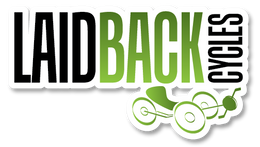By Bryan J. Ball
Managing Editor – BentriderOnline.com
Posted on April 10, 2010
The Rover has been the target of a very aggressive and unique marketing campaign for the last month. TerraTrike’s numerous teaser pics and videos tossed around words like “Revolutionary” and “Game Changing”. Top TerraTrike dealers and at least one media member were even flown out to the company’s Grand Rapids, Michigan headquarters for a sneak peak of the new trike. Guesses on our message board ranged from a full suspension titanium tadpole to a cheap sub $500 delta. The actual trike is somewhere in between but definitely the lower end guesses were closer to the truth. Does the Rover live up to the hype? Read on to find out.
The Rover is definitely a pretty unique design. In its cheapest form the trike only costs $799 making it the cheapest high quality tadpole trike I’ve ever ridden. It’s 18” seat height is very high for a tadpole and makes it exceedingly easy to get in and out of. Its high-tensile steel frame uses a combination of square and round tubing that not only keeps the cost down but makes it more adjustable for leg length than any other tadpole on the market. It even fits children relatively easily. It also easily breaks down into a few small pieces that will fit into almost any trunk. It’s the first tadpole I’ve seen that uses no chain idlers at all. It has a 400 pound weight limit. Revolutionary? I don’t know but it definitely is poised to be a very high volume seller.
I can attest that the Rover does look a lot better in person than in pics and that the clean but industrial look does grow on you. I’ve also watched a few members of the Rover’s target audience try out everything that TerraTrike has to offer and walk away with two of these trikes. They never mentioned the looks. But… “Pretty” is probably a word that will not be tossed about much when describing the Rover. Much of this is due to the square main tube.
Square tubing usually equals cheap and to a point this is true of the Rover. Square tubing is cheaper to buy and easier to build with. Therefore it does play a part in the Rover’s low MSRP. However, I have to hand it to TerraTrike for making the most of the material’s attributes. The seat slides over a long area with a very simple seat mount that wouldn’t work as well on a round tube. It also makes taking the trike apart and putting it back together a breeze. And that big square tube does lend itself to all sorts of aftermarket shenanigans. Mounting accessories should be a breeze for anyone with half an ounce of ingenuity. And the trike’s modular design also means that this almost certainly not the last development we’ll see of this basic frame design from TerraTrike.
The Rover comes in two versions. The $799 three speed model uses the venerable, old-as-time-itself Sturmey Archer 3-Speed hub. The $999 eight speed uses the much newer Sturmey Archer 8-Speed. Both of these hubs are about as reliable as taxes. Both models come with Zoom disc brakes and a 32 tooth crankset.
As I stated earlier, the Rover is very easy to get in and out of. If you can get in and out of your average sofa, you can manage this trike. The bottom bracket is a few inches lower than the seat so numb feet and toes should not be a problem at all either. The Rover’s seat frame is the same as the one that comes on TerraTrikes other budget models but uses a different canvas seat cover. It’s not as breathable as the others in the line-up but upgrading is pretty inexpensive if that bothers you. Other than that, it’s just as comfortable as the seat on any other TerraTrike. The handlebars are also at a very comfortable height. Comfort and ease of use were obviously at the top of the Rover’s design priority list.
When you first stomp on the pedals of a Rover, the first thing you notice is… nothing. With no idlers at all, this is by far the quietest tadpole I’ve ever ridden. There’s a quiet whir from the chaintubes but even that is much quieter than usual since the lines are so straight. There’s also not much rattle from the chain or anything else when you hit a bump.
The Rover feels pretty stiff when pedaling hard although there is some flex from the seat mount. At 42 lbs, the Rover is hardly a featherweight and it’s not meant to be a performance machine. It’s definitely not but it did feel a bit quicker than I expected at first glance. The Rover is aptly described as “efficient” rather than “quick”.
With an 18” seat height this trike is also not going to set any records in the slalom but I have to say that I was quite impressed with the handling. Hardish cornering yields a bit of uneasiness but it definitely did not feel at all “tippy”. Extremely hard braking did lift the rear wheel but the adjustability of the trike does let you keep your weight relatively centered to keep this to a minimum. There was virtually no brake or pedal steer and the direct steering was smooth and predictable. In short, there is nothing that should surprise or frighten a first time rider one bit. The turning circle is also the tightest I’ve seen in a tadpole trike. I think that in day-to-day practice this stat is a bit overrated but the Rover can turn on a dime when called upon to do so.
In the past, I’ve not been much a fan of trikes with “only” eight or nine gears. I lived in the mountains. I didn’t know any better. Sales figures of recumbents and uprights alike indicate that hub gears are “the in thing”. Now that I live in a city with bike paths and not as many mountains, I find myself in my middle chainring 90{1603412a7d9e235bc2262b7f3ef07f27b0f0da4c7a911810d5b09776c009474c} of the time and am much less down on these simpler drivetrains. I rode the 8-speed for this review and found the 23-72” gear range to be just about pitch perfect for this type of trike. It can get up most hills just fine and it was never meant to be a speed demon. It cruises along at 17 or so miles per hour quite comfortably and that will be just fine thanks. And especially for the first time trikers the Rover is aimed at, it’s pretty hard to argue with the simplicity and reliability of an internally geared hub.
And yes… It comes apart. It’s by no means a true folder but it can be broken down for transport and can fit into the trunk of almost any car. If you can do… well… anything around the house you can manage to break down a Rover.
All of TerraTrike’s stock accessories fit the Rover so it can be kitted out to fit most needs. It also ships with an eight-color sticker kit to personalize it however you see fit.
So there you have it… This is what we’ve all been waiting for. Is it a trike aimed at our core audience of enthusiasts? Not really but I could definitely see owning one as a commuter/utility trike. (It is very visible in traffic for a tadpole and well suited for city riding) Will it bring new masses to the market? I think so. It’s comfortable, easy to get in and out of, simple to operate, handles well, is well made, comes from a company with outstanding customer service and is relatively inexpensive. That’s a pretty good formula for something that is definitely, “very significant” if not outright “revolutionary”.
TERRATRIKE ROVER
Highs – Good handling, Very quiet, Exceedingly useable
Lows – Looks may have to grow on you


